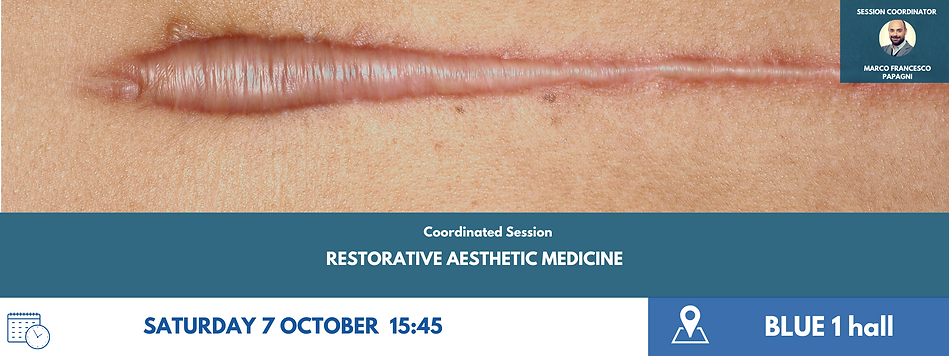Rational of the session
Since 2020, we have wanted to give continuity to the theme of Restorative Aesthetic Medicine, a theme of ever-increasing relevance and evolving in the field of Aesthetic Medicine. The Aesthetic Medicine that we all know, was born in 1973 but from that date to today there have been important developments and changes up to the union of the definition of Aesthetic Medicine with the term Restitutiva. This combination arises from a need: that, in fact, to return to the patient the integrity of his body pattern, perhaps altered or lost due to traumatic events or seriously debilitating pathologies, which then led to the appearance of annoying imperfections representing an important psychological burden for the patient.
This vision of aesthetic medicine is increasingly gaining ground, expanding and affecting other medical branches, such as oncology. It is therefore very important to try to put together as many experiences as possible in order to identify a direction to follow as well as a different know-how among professionals in order to address the issue, from different angles, with a broad and capillary vision: the sharing of experiences and knowledge is therefore essential especially in those areas that are still to be built.
Updates and news
As more and more patients demonstrate the need to obtain a restoration of what is their body scheme gone lost, just to highlight and to demonstrate
scientifically the psychological importance that these medical therapies can have on the patient and therefore on his well-being, it was decided to carry out, from 2021, a project on this issue. The project called Help acronym of Help for Esthetics Long lasting Problems is a project dedicated to the collection of data, in a totally anonymous form, that belong precisely to this type of patients who are post pathological or post traumatic and who need an aesthetic and psychological restoration. This initiative, structured as an interview that the patient can give, will allow the collection of reliable and scientific data that first demonstrate the need for these patients to achieve a restoration of previous health status and the importance of medical treatments that can be implemented for the benefit of this category of patients.
Restorative Aesthetic Medicine is absolutely a social medicine, it is the medicine itself that is "social" and therefore could not be different for each of its nuances.
In our area, the social aspect has a privileged and brilliant position because sometimes healing does not directly follow the fact of smiling again because of the results that this has entailed.
With this powerful medical, scientific and social "tool" we have the chance to make this type of patient smile again: this is our aim and our and their need.
This "need" still very little known and enlightened will be investigated and codified thanks to the project H.E.L.P. Any patient who has suffered a small or large aesthetic deficit due to an illness or trauma can participate in this data collection in a completely confidential way.
The collection of answers, in fact, allows to create anonymously a profile of the patient, of his problems and needs and to be able to highlight and illuminate, with scientific data, this important reality.
Take home messages
Among the main objectives that the session aims to achieve, special mention certainly have, indications and techniques of uncommon use of the tools we have available and extremely interesting and useful, in the right cases, which can make the difference in obtaining a satisfactory result.
In addition, sometimes the condition of candidate patients - ideal for restorative aesthetic medicine are so particular or delicate as to make the appearance of possible side effects more likely, it is therefore essential to always have a certain attention to this aspect and know how far you can go and when to abstain.
The most current and futuristic content has always been the added value that makes this session unique.
SCHEDULE OF THE SESSION
SESSION COORDINATOR
CHAIRS
Maurizio Cavallini, Monica Renga
Ennio Orsini | Post-surgical reconstruction of areola-nipple: updates, alternatives and complications | |
Monica Baldessin | Non-ablative vaginal laser in the treatment of genitourinary syndrome in patients with previous hormone-dependent cancer | |
Ilaria Ruggiero | When Aesthetic Medicine becomes treatment in the patients with cancer | |
Riccardo Lazzari | A particular scar: study of a clinical case in progress | |
Roberto Dell'Avanzato | Acne scar outcomes: combined laser treatment | |
Marco Francesco Papagni | in aesthetic medicine | |
Silvia Caboni | Approach to the disimmune patient in Aesthetic Medicine |

.png)